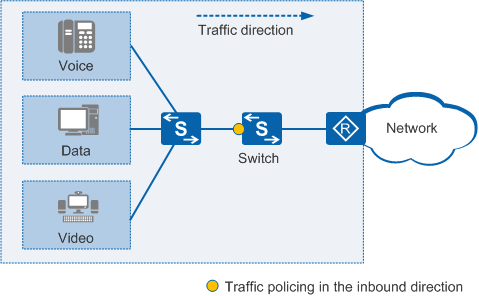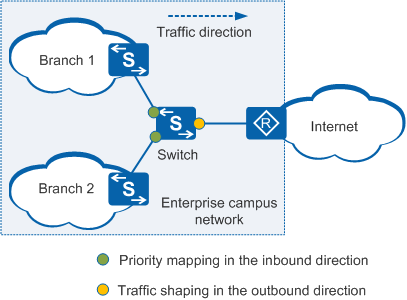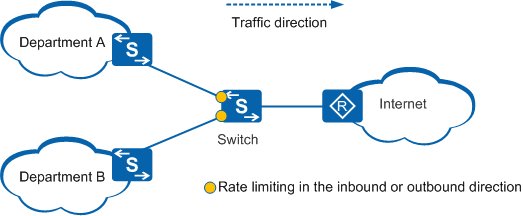Application Scenarios for Traffic Policing, Traffic Shaping, and Interface-based Rate Limiting
Traffic Policing
Networking Requirements
As shown in Figure 1, voice, video, and data services are transmitted on a network. When a large amount of traffic enters the network, congestion may occur due to insufficient bandwidth. Different bandwidth guarantees must be provided for the voice, video, and data services, listed in descending order of priority. In this situation, traffic policing can be configured to provide the highest guaranteed bandwidth for voice packets and the lowest guaranteed bandwidth for data packets. This configuration ensures preferential transmission of voice packets when congestion occurs.
- Configure traffic classifiers to classify voice, video, and data packets.
- Configure traffic behaviors to limit rates of the voice, video, and data packets.
- Associate the traffic classifiers with the traffic behaviors in a traffic policy, and apply the traffic policy to the inbound direction of an interface.
Traffic Shaping
Networking Requirements
On a network, traffic sent to the Internet may be discarded if bandwidth is insufficient. To prevent traffic loss, configure traffic shaping on the outbound interface of the upstream device to buffer excess traffic. Different traffic shaping rates can be configured for different branches, as shown in Figure 2.
- Configure priority mapping for incoming traffic on the interfaces of the switch connected to the branches. Packets from different branches are then marked with different local priorities and enter different queues.
- Configure traffic shaping on the outbound interface of the switch connected to the egress gateway to limit rates of traffic from different branches.
Interface-based Rate Limiting
Networking Requirements
As shown in Figure 3, a switch connects to two departments. The rate of traffic from each department cannot exceed a specified value. Rate limiting can be configured on the inbound interfaces of the switch to limit the rate of traffic from the two departments. Excess traffic will be discarded.
- Configure rate limiting on the switch's interfaces connected to the departments to limit the traffic rate of each department within a specified range.


